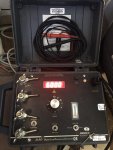Have a multi complex apt. building with the main disconnects and meter pacs in a single mechanical room. They leave the room running down into a slab on grade first floor. All conduits leaving the room are 1 1/4 GRC. They then go underground to the apt they feed. three story building so some go thru the walls and flooring up from the main floor. Some runs are in excess of 200 feet.......52 unit apt. building built in 1968-69.
I am having a grounding issue and am wondering if some of the buried ridged conduits have somehow come apart and not making a good ground anymore..
Is there ideas on how to check if this is the case? Can a megger be hooked up to the conduit at one end and then the other to see if the readings are the same. Or will the voltage from the megger just go straight to ground without running the length of the conduit to the apt. ? Which is what i envisioning happening, but i have only used meggers on testing insulation values.
Or is there any instrument/s out there that will do the above............or any other ideas on how to prove the conduit has and is getting a good ground......other than just continuity.
thanks for any help you can contribute....
I am having a grounding issue and am wondering if some of the buried ridged conduits have somehow come apart and not making a good ground anymore..
Is there ideas on how to check if this is the case? Can a megger be hooked up to the conduit at one end and then the other to see if the readings are the same. Or will the voltage from the megger just go straight to ground without running the length of the conduit to the apt. ? Which is what i envisioning happening, but i have only used meggers on testing insulation values.
Or is there any instrument/s out there that will do the above............or any other ideas on how to prove the conduit has and is getting a good ground......other than just continuity.
thanks for any help you can contribute....


